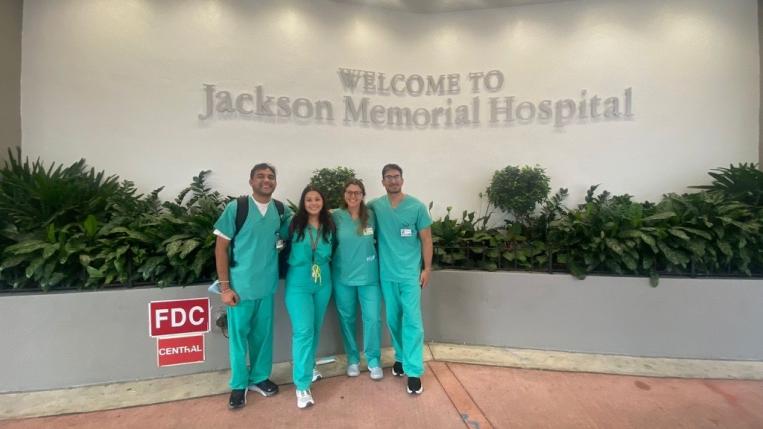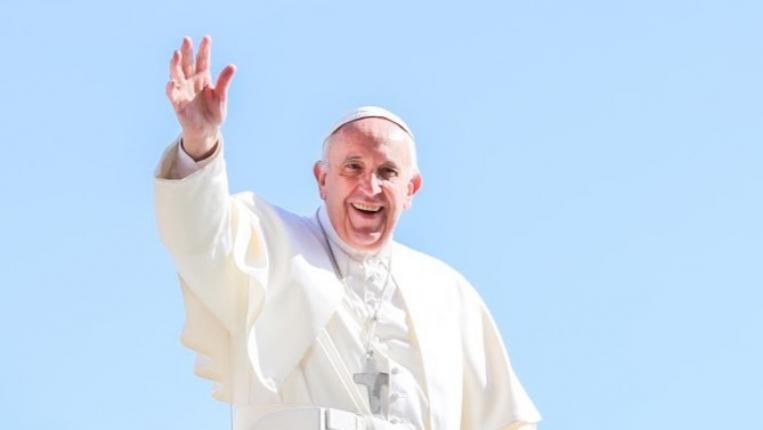"My name is Luana Savaget, and I am a fourth-year medical student at Católica Medical School. During the end of August and the beginning of September 2024, I had the opportunity to do an observership at Jackson Memorial Hospital (JMH) in Miami, Florida.
Jackson Memorial Hospital is one of the best and largest hospitals in Florida, and the Miami Transplant Institute (MTI) at JMH is the largest transplant center in the U.S., which is why I was interested in going after an opportunity of doing an observership there.
Having been born in Rio, Brazil, but having studied in American schools all my life, I have always inclined to go to the U.S. in my future, either to complete my medical education, or as part of my professional life.
Those who know me understand that I am always asking my professors to let me shadow them or go to the OR with them—honestly, anything that allows me to learn and gain experience in a hospital setting. I am a very practical and hands-on person, so I learn best through action. My desire to go to JMH stemmed from these experiences; I wanted to be able to observe and learn about the daily life of a surgeon at a world-renowned hospital, particularly in an area I wouldn’t normally have the opportunity to observe here in Lisbon: kidney transplant.
My experience there was beyond anything I could have ever imagined. I confess I was scared at first, diving into a very specific area of surgery, with highly skilled professionals including doctors, nurses, and pharmacists, at a hospital where I barely knew anything, without my professors in the OR like I have here in Lisbon. I was worried that it was too much for me to handle and that I would feel lost and uncomfortable. Thankfully, it wasn’t like that.
I won’t lie; it was hard work. Before going to Miami, I spent a couple of days during my vacation preparing for the observership. This preparation included reading past notes from lectures, pharmacology, reviewing extensively the abdomen anatomy, physiology, pathology, immunosuppression, and understanding how a kidney transplant was done because I had no experience with this topic. I wanted to be minimally prepared, so I wouldn’t feel like I was jumping out of a plane with no parachute.
The routine of the kidney transplant surgery team consists of the following:
Every day at 9 a.m. multidisciplinary rounds start on the inpatient transplant floor. During this time, the surgeons discuss the status of the post-surgery patients in a group with the advanced practice registered nurses (APRNs) and pharmacists, addressing any changes in lab values during the night, complaints, etc.
Monday afternoons the surgeons have pre transplant evaluation in the MTI clinic
Tuesdays and Wednesdays afternoons the surgeons have pre- and post-transplant evaluation in the MTI clinic
Living donor nephrectomies and Living donor kidney transplant are usually scheduled on Tuesdays/Wednesdays in the morning.
Deceased donor kidney transplants/Simultaneous kidney pancreas transplants can happen in random time. So, it was up to the students/ observer’s discretion as some cases can happen at very late hours.
As you can see, our routine was mildly chaotic, but it was also a lot of fun.

For me, the rounds were the hardest part. They really challenged me to recall and apply the information I had learned previously to understand patients’ clinical histories and exams, along with the pathophysiology. It was all the information from textbooks coming to life. It put our clinical knowledge and reasoning to the test.
In the kidney transplant team, there were a couple of other amazing students with me, ones that became good friends. We would go together to the rounds during the morning, and after they concluded, which could take about 2 hours, we would go down to the OR floor and see on the TV panels they have there, that state the time, surgery, OR room, procedure, and any interesting surgery that we could observe.
During my second day there, I got to see my first-ever robotic surgery! Those in medicine or even those who are not, may have heard of something called Da Vinci — a $2 million dollar robot that is able to perform minimally invasive surgery. It is as amazing as it sounds, and as I thought it would be. The skill required for the surgeon to master it is completely amazing and mind-blowing to me.
Living-donor kidney transplant (LDKT) surgery — that is, a surgery of a donor who willingly donates his kidney (for example, I’ve seen a 90kg father donate his left kidney to his 26kg daughter because she had hemolytic uremic syndrome) — if suitable, is usually done with robotic surgery as it is far superior, while the recipient undergoes open surgery. It was also here that I learned that recipients of a new kidney actually have 3 kidneys, with the new one being placed in the right iliac fossa with anastomosis to the external iliac artery and vein, along with anastomosis of the ureter to the bladder.
Watching my first kidney transplant surgery, I was a little lost even though I studied the surgery before, because anatomy in textbooks does not quite compare to seeing it through a camera inserted in a patient’s abdomen. However, as I observed more and more surgeries, I began to make better sense of them, and understand each meticulous step, in each specific order, and why it was done the way it was done. I’ve seen many surgeries before in many different areas, it’s my passion, and I know it is what I want to, and will hopefully do in my future, but that experience truly fascinated me almost like no other has.
As I got more comfortable throughout the days, I made an effort to observe other things as well to make the most out of my time there. One of the things that shocked me the most was watching a liver transplant, famous among transplant surgeons for being quite challenging.
The liver arrived from Orlando, FL at 14h30 on a Sunday. When a new organ arrives at a transplant center, it must be prepared by the surgeons before it is placed into the recipient. This liver preparation included removing unnecessary tissues, preparing vessels and biliary ducts for anastomoses, making sure there are no leaks in the vessels, etc. Once the preparation was finished on a side room, the surgeons preparing the liver and I returned to the OR table where the recipient was being prepared by other surgeons to receive the liver. As I got there, I saw a pool of blood on the floor, the surgeons’ scrubs all covered in blood, the patients vital signs almost crashing with a HR of 140 and a BP of 60/30. Six hours into surgery the patient had lost an alarming amount of blood, and by the time I lost track, they had used 50 packs of O- blood and 20 packs of fresh frozen plasma (FFP). A thrombus had formed at the site of the hepatic artery anastomosis, forcing the surgeons to redo the procedure. The rest of the surgery is now history and a testament to the wonders that can occur in medicine. I’ve never seen a surgery that was so concerning, yet for the team, it was just another day in the life of a transplant surgeon.
My journey through the OR continued, and I saw more transplant surgeries, neurosurgeries, and cardiothoracic surgeries, always putting to test my knowledge, and always seeking to learn from those around me. I saw procedures I once only read in textboooks, and could have never imagined to see them in real life.
Being an observer in the kidney transplant area (and well, a couple other areas) at JMH was an amazing experience. I was alongside very capable professionals who added a lot to my academic knowledge and personal growth. I was lucky to have met amazing people there, some whom I now consider great friends.
It is definitely an experience that I will forever be grateful for and treasure. It gave me invaluable insights into the realities of medicine that go beyond textbooks and imagination and made me question what I want my future in medicine to be like.
I cannot wait to return there in the future—this time, as an MD."



